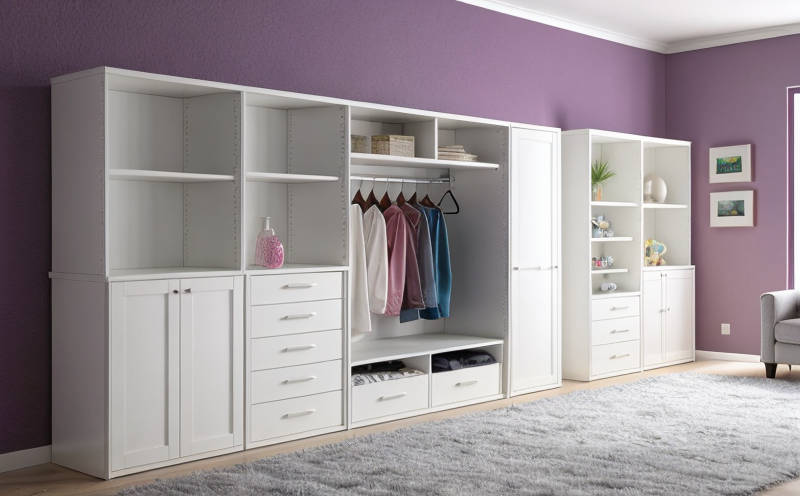BS 4875 Furniture Strength and Durability Methods Applied to Cabinets Testing
The British Standard BS 4875 is a recognized benchmark in furniture testing that focuses on establishing methods for assessing the strength and durability of furniture. This standard applies specifically to storage furniture, including cabinets, which are subjected to rigorous mechanical tests designed to evaluate their structural integrity and longevity under various stress conditions. The primary objective of this service is to ensure that products meet stringent quality standards and comply with regulatory requirements.
Storage furniture like cabinets form a significant part of any household or office setting, serving not only functional purposes but also aesthetic ones. However, the durability of these items can be compromised by various factors such as improper material selection, inadequate manufacturing processes, or harsh environmental conditions. By applying BS 4875 testing methods, manufacturers and suppliers can enhance product reliability and customer satisfaction.
The BS 4875 test protocol involves multiple steps aimed at evaluating different aspects of cabinet strength and durability. These include static load tests to determine the maximum weight a cabinet can support without failing, fatigue loading tests to simulate prolonged use over time, impact resistance assessments to gauge resilience against accidental impacts, and environmental exposure evaluations to assess performance in varied climatic conditions.
For accurate testing, specimens are prepared according to specified dimensions and configurations outlined in the standard. Appropriate fixtures and equipment must be used for each test type to ensure reliable results. Afterward, detailed reports detailing findings are generated, highlighting any areas of concern along with recommendations for improvement if necessary.
The importance of adhering strictly to BS 4875 cannot be overstated when it comes to ensuring the safety and longevity of storage furniture products. Compliance not only protects end users but also shields manufacturers from potential legal issues related to product liability claims. Moreover, meeting these standards can significantly enhance brand reputation among consumers who value high-quality, durable goods.
In recent years, there has been growing awareness about sustainable practices within the manufacturing industry. BS 4875 testing plays a crucial role in promoting this shift towards eco-friendly production methods by encouraging the use of recyclable materials and energy-efficient processes during fabrication stages. Additionally, it helps identify potential improvements that could lead to reduced waste generation throughout product lifecycle.
By incorporating BS 4875 into their quality assurance programs, companies demonstrate commitment to delivering top-notch products while maintaining responsible business practices. This approach fosters trust between manufacturers and customers, ultimately contributing to long-term success in the market.
Scope and Methodology
The scope of BS 4875 testing for storage furniture cabinets encompasses various mechanical stresses that these items may encounter during regular use. The methodology involves performing several key tests aimed at assessing different properties such as strength, stability, resistance to deformation, and overall durability.
- Static Load Testing: This test determines the maximum load a cabinet can bear without sustaining damage or failure. Specimens are placed under increasing weights until they collapse or deform beyond acceptable limits.
- Fatigue Loading Tests: These tests simulate long-term usage scenarios by applying cyclic loads to cabinets over extended periods, helping identify signs of wear and tear indicative of reduced performance.
- Impact Resistance Assessments: Cabinets are exposed to simulated impacts from various sources (e.g., dropping objects) to measure their ability to withstand such forces without sustaining critical damage.
- Environmental Exposure Evaluations: Specimens are subjected to controlled environmental conditions that mimic real-world situations, including temperature fluctuations, humidity levels, and exposure to sunlight, to evaluate durability under these challenging circumstances.
The results from each test provide valuable insights into the structural integrity and longevity of storage furniture cabinets. These data points guide manufacturers in optimizing design elements, selecting appropriate materials, and implementing quality control measures throughout the production process.
Benefits
Implementing BS 4875 testing for storage furniture cabinets offers numerous advantages that extend beyond mere compliance with regulatory requirements. Here are some of the key benefits:
- Increased Consumer Confidence: Adhering to this standard enhances trust among consumers by ensuring they receive products built to last, thereby increasing customer satisfaction and loyalty.
- Enhanced Product Quality: Rigorous testing helps identify weaknesses early in the development phase, allowing for necessary adjustments before mass production begins.
- Competitive Advantage: Meeting international standards like BS 4875 sets companies apart from competitors, potentially leading to increased market share and higher profit margins.
- Sustainability: By incorporating sustainable practices into the testing process, manufacturers can contribute positively towards reducing environmental impact throughout the entire product lifecycle.
- Legal Protection: Compliance with recognized standards like BS 4875 minimizes risk of litigation arising from defective products or injuries caused by unsafe furniture items.
Beyond these tangible benefits, there is an intangible advantage in aligning oneself with global best practices. This positioning strengthens brand identity and reputation among both industry peers and end users alike.





